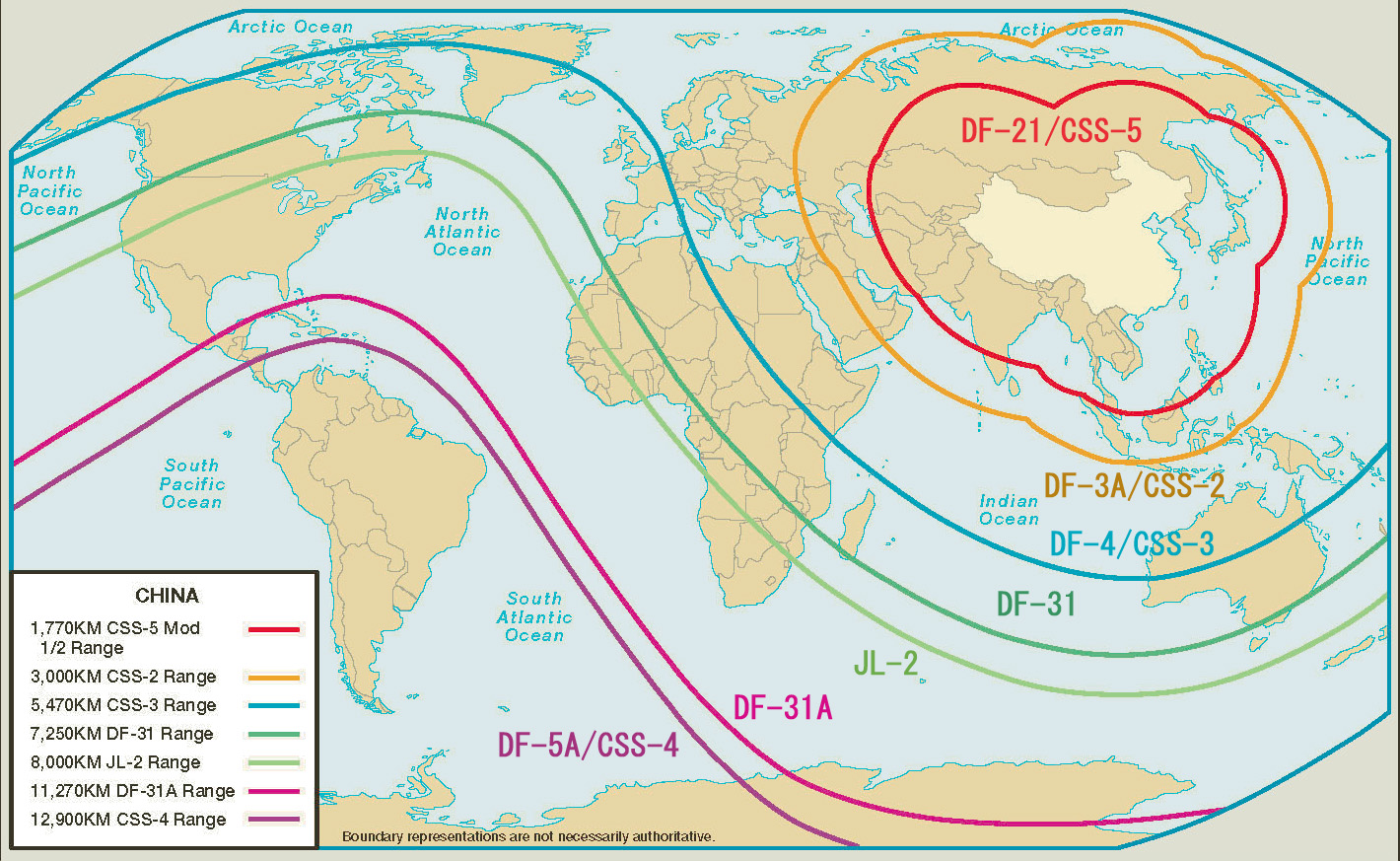|
Dongfeng 21
The Dong-Feng 21 (DF-21; NATO reporting name CSS-5 - Dong-Feng () is a two-stage, solid-fuel rocket, single-warhead medium-range ballistic missile (MRBM) in the Dongfeng (missile), Dong Feng series developed by China Changfeng Mechanics and Electronics Technology Academy. Development started in the late 1960s and was completed around 1985–86, but it was not deployed until 1991. It was developed from the submarine-launched JL-1 missile, and is China's first solid-fuel land-based missile. The United States Department of Defense, U.S. Department of Defense in 2008 estimated that China had 60-80 missiles and 60 launchers; approximately 10-11 missiles can be built annually. Originally developed as a strategic weapon, the DF-21's later variants were designed for both nuclear and conventional missions. It is thought able to carry a high explosive, cluster munition, submunition, or 300 kt nuclear warhead. The latest DF-21D was said to be the world's first anti-ship ballistic missil ... [...More Info...] [...Related Items...] OR: [Wikipedia] [Google] [Baidu] |
Transporter Erector Launcher
A transporter erector launcher (TEL) is a missile vehicle with an integrated tractor unit that can carry, elevate to firing position and launch one or more missiles. History Such vehicles exist for both surface-to-air missiles and surface-to-surface missiles. Early on, such missiles were launched from fixed sites and had to be loaded onto trucks for transport, making them more vulnerable to attack, since once they were spotted by the enemy they could not easily be relocated, and if they were it often took hours or even days to prepare them for launch once they reached their new site. Usually a number of TELs and TELARs are linked to one command post vehicle (CP or CPV). They may use target information from target acquisition, designation and guidance radar (TADAGR or TAR). Transporter erector launcher and radar A transporter erector launcher and radar (TELAR) is a type of TEL that also incorporates part or all of the radar system necessary for firing the surface-to-air missil ... [...More Info...] [...Related Items...] OR: [Wikipedia] [Google] [Baidu] |
Submarine
A submarine (or sub) is a watercraft capable of independent operation underwater. It differs from a submersible, which has more limited underwater capability. The term is also sometimes used historically or colloquially to refer to remotely operated vehicles and Autonomous underwater vehicle, robots, as well as medium-sized or smaller vessels, such as the midget submarine and the wet sub. Submarines are referred to as ''boats'' rather than ''ships'' irrespective of their size. Although experimental submarines had been built earlier, submarine design took off during the 19th century, and they were adopted by several navies. They were first widely used during World War I (1914–1918), and are now used in many navy, navies, large and small. Military uses include attacking enemy surface ships (merchant and military) or other submarines, and for aircraft carrier protection, Blockade runner, blockade running, Ballistic missile submarine, nuclear deterrence, reconnaissance, conventio ... [...More Info...] [...Related Items...] OR: [Wikipedia] [Google] [Baidu] |
Initial Operating Capability
Initial operating capability or initial operational capability (IOC) is the state achieved when a capability is available in its minimum usefully deployable form. The term is often used in government or military procurement. The United States Department of Defense chooses to use the term ''initial operational capability'' when referring to IOC. For a U.S. Department of Defense military acquisition, IOC includes operating the training and maintaining parts of the overall system per DOTMLPF, and is defined as:"In general, attained when some units and/or organizations in the force structure scheduled to receive a system have received it and have the ability to employ and maintain it. The specifics for any particular system IOC are defined in that system’s Capability Development Document (CDD) and Capability Production Document (CPD)."The date at which IOC is achieved often defines the in-service date (ISD) for an associated system. Declaration of an initial operating capability ma ... [...More Info...] [...Related Items...] OR: [Wikipedia] [Google] [Baidu] |
National Air And Space Intelligence Center
The National Air and Space Intelligence Center (NASIC) is the United States Air Force unit for analyzing military intelligence on foreign air and space forces, weapons, and systems. NASIC assessments of aerospace performance characteristics, capabilities, and vulnerabilities are used to shape national security and defense policies and supports weapons treaty negotiations and verification. History In 1917 the Foreign Data Section of the Army Signal Corps’ Airplane Engineering Department was established at McCook Field, and a NASIC predecessor operated the Army Aeronautical Museum of the Material Division, August 22, 1935. The Office of the Chief of Air Corps's Information Division had become the OCAC Intelligence Division by 1939, which transferred into the United States Army Air Forces (USAAF) as AC/AS, Intelligence and was known as A-2 (in April, 1942, the Air Intelligence School was at the Harrisburg Academy.) The United States Army Air Forces evaluated foreign aircraft ... [...More Info...] [...Related Items...] OR: [Wikipedia] [Google] [Baidu] |
PLA Ballistic Missiles Range
PLA may refer to: Organizations Politics and military * People's Liberation Army, the armed forces of China and of the ruling Chinese Communist Party * People's Liberation Army (other) ** Irish National Liberation Army, formerly called the People's Liberation Army ** People's Liberation Army (Lebanon) ** People's Liberation Army of Manipur, India * Palestine Liberation Army, the military wing of the Palestine Liberation Organization * ProLife Alliance, a former UK political party Other organizations * Pacific Locomotive Association, operator of the Niles Canyon Railway in California, US * Pakistan Library Association * Pediatric Leadership Alliance, of the American Academy of Pediatrics * Phone Losers of America, a US phone phreaking group * Port of London Authority, England * Pre-school Learning Alliance, England * Public Library Association, a US professional association Science and technology * Principle of least astonishment, a principle in software design * Progra ... [...More Info...] [...Related Items...] OR: [Wikipedia] [Google] [Baidu] |
Dongfeng-21D
The Dong-Feng 21 (DF-21; NATO reporting name CSS-5 - Dong-Feng () is a two-stage, solid-fuel rocket, single-warhead medium-range ballistic missile (MRBM) in the Dong Feng series developed by China Changfeng Mechanics and Electronics Technology Academy. Development started in the late 1960s and was completed around 1985–86, but it was not deployed until 1991. It was developed from the submarine-launched JL-1 missile, and is China's first solid-fuel land-based missile. The U.S. Department of Defense in 2008 estimated that China had 60-80 missiles and 60 launchers; approximately 10-11 missiles can be built annually. Originally developed as a strategic weapon, the DF-21's later variants were designed for both nuclear and conventional missions. It is thought able to carry a high explosive, submunition, or 300 kt nuclear warhead. The latest DF-21D was said to be the world's first anti-ship ballistic missile (ASBM). The DF-21 has also been developed into a space-capable anti-sate ... [...More Info...] [...Related Items...] OR: [Wikipedia] [Google] [Baidu] |
Terminal Guidance
In the field of weaponry, terminal guidance refers to any guidance system that is primarily or solely active during the "terminal phase", just before the weapon impacts its target. The term is generally used in reference to missile guidance systems, and specifically to missiles that use more than one guidance system through the missile's flight. Common examples include long-range air-to-air missiles that use semi-active radar homing (SARH) during most of the missile's flight, and then use an infrared seeker or active radar homing once they approach their target. Similar examples include surface-to-air missiles, anti-ballistic missiles, and some anti-tank missiles. Concept Radar beams are cone-shaped, spreading out from the diameter of the antenna at a characteristic angle that is a function of the size of the antenna and its wavelength. This means that as one moves away from the radar, its accuracy continues to degrade while the signal grows weaker. This makes it difficult to use ... [...More Info...] [...Related Items...] OR: [Wikipedia] [Google] [Baidu] |
Circular Error Probable
In the military science of ballistics, circular error probable (CEP) (also circular error probability or circle of equal probability) is a measure of a weapon system's precision. It is defined as the radius of a circle, centered on the mean, whose perimeter is expected to include the landing points of 50% of the rounds; said otherwise, it is the median error radius. That is, if a given munitions design has a CEP of 100 m, when 100 munitions are targeted at the same point, 50 will fall within a circle with a radius of 100 m around their average impact point. (The distance between the target point and the average impact point is referred to as bias.) There are associated concepts, such as the DRMS (distance root mean square), which is the square root of the average squared distance error, and R95, which is the radius of the circle where 95% of the values would fall in. The concept of CEP also plays a role when measuring the accuracy of a position obtained by a navigati ... [...More Info...] [...Related Items...] OR: [Wikipedia] [Google] [Baidu] |
Hard Launch
Hard launching is a launch system of a guided missile, where the missile's rocket engine is ignited while still inside the launch assembly or tube. This is technically simpler than soft launching but produces a large backblast area. See also *Soft launch (missile) Soft launching is the method of launching a missile (such as an anti-tank guided missile) in such a way that the rocket motor ignites outside of the launch tube; the missile is ejected non-explosively. The objective is to minimize the risk of dama ... * Hot launch and cold launch Missile launchers Missile operation Guided missiles {{missile-stub ... [...More Info...] [...Related Items...] OR: [Wikipedia] [Google] [Baidu] |
Anti-satellite Weapon
Anti-satellite weapons (ASAT) are space weapons designed to incapacitate or destroy satellites for strategic or tactical purposes. Several nations possess operational ASAT systems. Although no ASAT system has been utilised in warfare, a few countries (China, India, Russia, United Kingdom and the United States) have successfully shot down their own satellites to demonstrate their ASAT capabilities in a show of force. ASATs have also been used to remove decommissioned satellites. ASAT roles include: defensive measures against an adversary's space-based and nuclear weapons, a force multiplier for a nuclear first strike, a countermeasure against an adversary's anti-ballistic missile defence (ABM), an asymmetric counter to a technologically superior adversary, and a counter-value weapon. Use of ASATs generates space debris, which can collide with other satellites and generate more space debris. A cascading multiplication of space debris could cause Earth to suffer from Ke ... [...More Info...] [...Related Items...] OR: [Wikipedia] [Google] [Baidu] |
Anti-ship Ballistic Missile
An anti-ship ballistic missile (ASBM) is a military ballistic missile system Anti-ship missile, designed to hit a warship at sea. Due to the often hypersonic flight speed of ballistic missiles an ASBM's kinetic energy alone may be sufficient to cripple or outright destroy a supercarrier with a single conventional weapon, conventional warhead impact. Unlike a nuclear warhead, however, this would require a direct hit to be effective; therefore unlike a typical ballistic missile, which follows a ballistic trajectory, ballistic flight path after the relatively brief initial phase of powered flight, an ASBM would require a precise and high-performance terminal guidance system with advanced sensors and in-flight calibrations in order successfully to hit a moving target. Soviet Union The 4K18 was a Soviet, Soviet Union intermediate-range ballistic anti-ship missile (also known as R-27K, where "K" stands for Korabelnaya which means "ship-related") NATO SS-NX-13. Initial submarine tes ... [...More Info...] [...Related Items...] OR: [Wikipedia] [Google] [Baidu] |
Cluster Munition
A cluster munition is a form of air-dropped or ground-launched explosive weapon that releases or ejects smaller submunitions. Commonly, this is a cluster bomb that ejects explosive bomblets that are designed to kill personnel and destroy vehicles. Other cluster munitions are designed to destroy runways or electric power transmission lines, disperse chemical or biological weapons, or to scatter land mines. Some submunition-based weapons can disperse non-munitions, such as leaflets. Because cluster bombs release many small bomblets over a wide area, they pose risks to civilians both during attacks and afterwards. Unexploded bomblets can kill or maim civilians and/or unintended targets long after a conflict has ended, and are costly to locate and remove. Cluster munitions are prohibited for those nations that ratified the Convention on Cluster Munitions, adopted in Dublin, Ireland, in May 2008. The Convention entered into force and became binding international law upon ratifyi ... [...More Info...] [...Related Items...] OR: [Wikipedia] [Google] [Baidu] |




